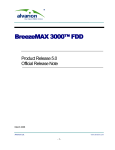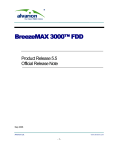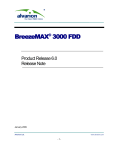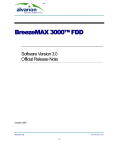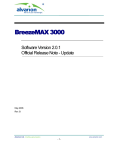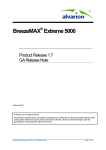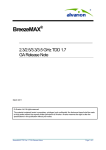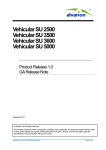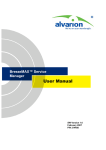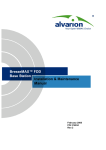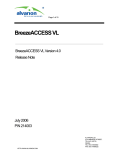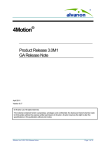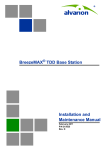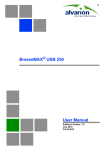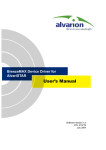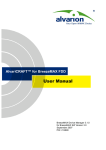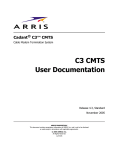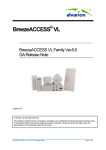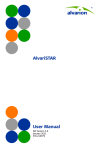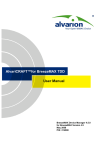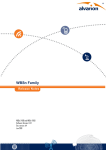Download Release Notes
Transcript
BreezeMAX 3000™ FDD
Product Release 5.5
Official Release Note
June 2008
Alvarion Ltd.
www.alvarion.com
-1-
General
This document details the main features, known limitations, version compatibility, bug fixing information
and the documentation available for the BreezeMAX 3000 FDD product release 5.5. It corresponds to
software versions 3.6.0.13 of the NPU (Network Processing Unit), 3.6.0.15 micro base station, 3.6.1.10
AU (access unit) and 3.6.1.10 SU (subscriber unit).
Introduction:
This release is based on SW version 3.5 of BreezeMAX 3000, and introduces new features in the
product, in all modules. The new software version is named version 3.6, and is part of product release
5.5.
Main Content and Features:
¾ IP Location Aware: Utilizing DHCP Option 82 transparent mode, having the ability to correlate
BS, SU, and end-user traffic. This is achieved by adding location related parameters in Option
82 fields of DHCP request (e.g. CPE MAC, BST MAC).
¾ SU Frequency scanning: Adding frequency scanning ability in the Subscriber Unit, enabling
automatic selection of base-station frequency within the pre-configured scanning range.
Includes also Best-AU (i.e. base-station) automatic selection rules. In order to maintain the
same system functionality with regards to frequency configuration, this feature is disabled by
default after the upgrade and can be configured to be enabled per SU from NPU and directly
over the SU via the web interface. – Trial mode only.
¾ Increase of number of supported DRAP voice services from 512 to 2000 per base station.
Thus expending the support of number of managed voiced entities per base-station.
¾ Support new VG’s with DRAP Introducing 2 new primary voice subscriber units for primary
voice with battery backup.
¾ MMC and 2nd order diversity in the 4CH-based AU-IDU and micro-BST – by supporting the 2nd
IF channel in the 4CH AU-IDU, adding the ability to work in MMC mode (Multi Modem Card)
with 7MHz channel spacing.
Alvaristar and Alvaricraft Support
Version 3.6 of BMAX Device is support starting from Device Driver version 4.5.0.72 of AlvariSTAR and
AlvariCRAFT.
AlvariSTAR 4.5.0.72 version has to be installed on AlvariSTAR infrastructure platform version 3.5.1.50
or later.
Alvarion Ltd.
www.alvarion.com
-2-
Known Problems & Limitations
Some problems and limitations will be addressed in future software versions.
Base Station
¾ AU ODU fails to initialize when IF cable is disconnected and connected again within 10
seconds.
¾ When the bandwidth available at the Base Station backbone is less than the traffic at the
wireless side, the prioritization of service types may not be maintained (it may happen that an
RT service is not prioritized to a BE service)
¾ The maximum possible throughput for multicast connection forwarding rule is 2.5 Mbps for
BreezeMAX PRO and PRO-S CPEs and 4.5 Mbps for BreezeMAX CPEs.
¾ The management port is for local management only. The management port may be used only
when the network is different from the data port (i.e. another router interface). The restriction
evolves from preventing the use of the same physical router MAC address for both data and
management ports.
¾ Configuring an IP address 0.0.0.0 for either the data or management port is not allowed
¾ Setting factory defaults should be done from local RS-232, as management IP address is
changed during the process.
¾ The bridge aging table in the NPU uses a fixed time definition for aging that is user
configurable with default of 10 minutes.
¾ When testing Point-to-Point bi-directional UDP traffic, the ratio between downlink and uplink
traffic may not be symmetric (downlink traffic will take higher bandwidth than uplink traffic).
¾ In cases where an AU channel was disabled and the AU was reset, first attempt to re-enable
the channel will fail (although channel will report ("enabled")). However, second attempt to
enable this channel will succeed.
¾ In some cases, in order to downgrade the Micro/Modular NPU version from 3.6 to 3.0 (or to a
lower 3.5 version), one must go through downgrading the units version (in the shadow) to
version 2.5 and only then go to version 3.0.
¾ If a channel is disabled and the AU is reset, after AU reboot, the first try to re-enable the
channel will fail.
¾ In rare cases, when NPU Ethernet data port speed is configured to 1Gbps, the NPU may halt.
It is recommended to use a configuration of 100Mbps in this case.
¾ There might be situations during normal operation in which a slow response of the SNMP can
be noticed due to timeout of SNMP requests from inactive SU’s.
Alvarion Ltd.
www.alvarion.com
-3-
¾ In the process of upgrading an active 2 Ch AU with active services to 4 Ch AU, it is necessary
to upgrade to version 3.6 the 2 Ch AU and save the configuration as it has version 3.6 on it.
This configuration file can be applied after on the 4 channel AU and service will continue using
the configuration file from the 2 Ch AU.
Newly added:
¾ Frequency scanning can be locked on frequency which is 125KHz different from the BS
frequency. In this case, performance is not affected, it is compensated by DSP. In any case to
obtain the best frequency scanning performance, to configure start and stop frequencies and
to configure the channel spacing as available for the operator.
¾ BS ID and BS mask appears also on frequency scanning menu of the SU (accessed from
NPU), this is the same parameter as on the MAC menu.
¾ IP location aware implementation leaves the relay agent giaddr field IP address as 0.0.0.0. In
case BS router is used also as a DHCP server, it may interpret it as an attack and deny the
DHCP option 82 packet coming from BreezeMAX. In this case, the router must be configured
to recognize it as “Trusted” for such DHCP option 82 requests.
See as an example on Cisco site: http://slaptijack.com/networking/allowing-option-82-in-ciscodhcp-relay-agents.
¾ In this release, frequency scanning configuration is accessible only through telnet from NPU,
or directly from the SU. AlvariSTAR and AlvariCRAFT will support it on next release.
¾ While activating the new mode of QOS setting for DRAP voice signaling, the NPU becomes
less responsive for few minutes until if finishes configuring all DRAP sessions. In this case,
also a message informing a successful setting will be on telnet, after each connection is being
modified. This lasts only once, after the initial activation.
¾ In case the an AU SW doesn’t exists in NPU and the AU is configured by telnet to load that
inexistent version, the AU may get hanged.
¾ Configured SU name, must be in English characters, otherwise it will not be discoverable by
Alvaristar.
Subscriber units
¾ If ATPC is disabled, and TX power is set below 10 dB, the BreezeMAX PRO and PRO-S
CPE units might transmit with an inaccuracy of up to 5 dB.
¾ The WEB monitor application does not ask for password after SU is reset while logged in.
¾ Alvarion’s Voice Gateway will not work properly if Hybrid VLAN mode is enabled on one
of the services passing through the VG. Requires working in transparent VLAN mode.
Alvarion Ltd.
www.alvarion.com
-4-
¾ Software download to a BreezeMAX CPEs may fail in case uplink traffic is higher than
2.5Mbps specifically per CPE.
¾ When downloading a previous saved configuration file to a CPE, the common name and
location parameters are not updated.
¾ In BreezeMAX PRO CPE units, the following parameters are not present in the SU’s monitor:
Serial Number, RF Card HW Revision & Boot Version.
¾ In the Si CPE – in case external antenna is to be used, there is a need to configure the unit to
work with it. The default configuration is internal antenna no 3.
¾ When downloading upgrade software to SUs under micro base-stations with a large number
of SUs running in high load it is recommended to perform scheduled upgrade using
AlvariSTAR with no more that 5 concurrent SUs.
Counters
¾ RbPMConnDLI counter is not working.
¾ IfOutDiscards and ifInDiscards counters present inaccurate information.
¾ Packet loss counting for service performance monitor (Tx Vs. Rx) has a minor inaccuracy due
to the sampling time of transmitted vs. received counters.
Over long periods (several minutes), the inaccuracy is negligible.
ARQ
¾ Limited to 3.5MHz and 1.75MHz channel BW
¾ Limited to 256 SUs
¾ Packets per second on UL limited to 4500 pps. 512Bytes average packet size is the
point when throughout is not degraded.
¾ When SUs are out of link, capacity is reduced and therefore recovery is more exposed to
loss due to traffic
¾ If service QOS profile changes priority queue, ARQ will be immediately effective, only
next time connection will be established.
o
E.g. changing from NRT to RT, ARQ will continue to be applied until next time the
link to the SU will be established
¾ Packet loss due to capacity problem cannot be recovered. Therefore, to avoid packet loss due
to capacity, the system should not work in congestion. The packets discarded indication can
indicate whether this is the situation.
7MHz Mode
¾ HW Limitation
Alvarion Ltd.
www.alvarion.com
-5-
Base Station must have 4 Channels AU card
Only the first 2 IF channels out of the 4 channels are active, also in 3.5MHz Channel
BW mode
o SU must be Dual mode CPE Pro or Dual mode CPE Pro-S or Dual mode SU Self
Install.
Limited to 256 SUs
Only 2 channels out of the 4 channels are active
By design – SU MIR is limited to 12 mbps
SW (AU/SU) downgrade is blocked if 7MHz is configured
o
o
¾
¾
¾
¾
Notice Information
¾ If one ODU unit is already connected with traffic running through it, and the second ODU unit
is connected, there is a small interference period of 350 milliseconds on the first ODU unit.
Traffic may be interrupted and some CPEs may re-synch.
¾ When installing HP-ODU in existing or as replacement to ODU installations, it is necessary to
check if the IF cable needs to be changed due to different power consumption. More
information is detailed in the installation section of the BST manual.
¾ After installing unlimited BW license to the BST, the user must reset either the BST, AU or the
SU in order to change the operating status and receive the unlimited BW.
¾ In the 3.5GHz, installations of AU-ODU-HP requires using also a power feeder to provide the
power for these units.
Bugs Fixed & Improvements
In version 3.6:
¾ In 1.75MHz channel bandwidth, the distance between the BST and the CPE displayed on the
monitor was not accurate
¾ Cell radius parameter is now correct for 7MHz., 3.5MHz and 1.75MHz, no need to double the
configured distance in case 7Mhz is in use.
¾ SU’s which their license expired will not be disconnected as was on previous versions, they
will be limited to 2mbps.
¾ In case of having more than 200 SU’s associated to an AU, there are some situations when
slow association of the SUs to the BS can be noticed.
¾ In previous release, the new 4 Ch AU was supported only the first channel, currently also the
second channels is supported including diversity and multichannel functionality
¾ Several scenarios of AU reset caused due to: over processing of BW, DSP timing issues
¾ PPPoE traffic runs on multicast connection in case of transparent service
¾ Invalid subnet mask could be used for management and data port
Alvarion Ltd.
www.alvarion.com
-6-
¾ Event log bug – When a channel or AU that is not in use/ not installed, unnecessary trap will
not be issued
¾ SIP server address can accept also domain address configured in VG (not only IP address of
the SIP server)
¾ SU could remain hanged in “base station found” (Rx established) and didn’t have timeout
other than the 10 minutes of no association timeout.
¾ Telnet session was not closed at reboot
¾ Restore backup configuration requires second reset
¾ Close of Telnet session if not in use
¾ Additional mode of QOS setting for voice signaling working with DRAP service was added; it
keeps more BW for data sessions.
¾ Capacity counters were reported starting date year 1970 regardless how it is set by NPU.
¾ Subnet mask can not be set on the management and data port through SNMP
Compatibility
BreezeMAX software version is compatible according to the following tables:
Type of BST
BMAX 3300
CPE ver. 3.6
BMAX 3500
CPE ver. 3.6
BMAX 3600
CPE ver. 3.6
Modular
3.5; 3.0
3.5; 3.0
3.5; 3.0
Micro
3.5; 3.0
3.5; 3.0
3.5; 3.0
Type of CPE
BMAX 3300
BST ver. 3.6
BMAX 3500
BST ver. 3.6
BMAX 3600
BST ver. 3.6
CPE
3.5; 3.0
3.5; 3.0
-
PRO
-
3.5; 3.0
-
PRO-S
-
3.5; 3.0
3.5; 3.0
Si
-
3.5; 3.0
-
PRO-S 802.16e
ready
-
-
-
Si 802.16e
ready
-
-
-
Alvarion Ltd.
www.alvarion.com
-7-
Documentation
¾ BreezeMAX™ FDD Modular Base Station - System Manual
¾ BreezeMAX™ FDD Micro Base Station - System Manual
¾ BreezeMAX™ CPEs (PRO and Si CPEs) - Product Manual
¾ Base Stations (Modular & Micro) Installation & Maintenance - User Manual
¾ PRO CPE_S_Installation & Maintenance Manual
¾ CPE-IDU-1D and CPE-ODU-PRO Quick Installation Guide
¾ Si CPE Quick Installation Guide
¾ BreezeMAX™ FDD - Troubleshooting Guide
¾ BreezeMAX™ FDD - Traps and Alarms
¾ BreezeMAX™ FDD - Firmware Upgrade Procedure
¾ BreezeMAX™ 3000 FDD - Release Note
¾ Using the Multi Channel Modem (MMC) Feature – Technical Note
¾ MIB Changes – Technical Note
¾ BreezeMAX™ Getting and Loading Feature Licenses
¾ AlvariSTAR™ Getting and Loading Feature Licenses
Alvarion Ltd.
www.alvarion.com
-8-








